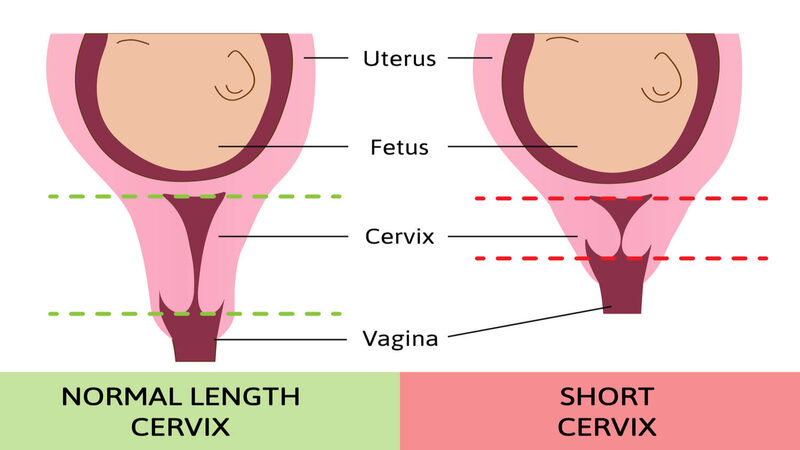
Every pregnancy aims for a healthy baby. Certain parts of the body play an important role in ensuring an uncomplicated pregnancy and delivery. However, in some cases, certain anatomical issues of the mother can result in a high-risk pregnancy. Cervical length in pregnancy is one such feature.
Having a normal cervical length in pregnancy is important for an uncomplicated pregnancy and delivery. This article tells you everything you need to know about cervix length in pregnancy, cervical length normal size, short cervix, risks, and other issues related to it.
What Is Cervical Length in Pregnancy?
The cervix is the lower part of the uterus that appears like a narrow tube that opens to the vagina. The cervical length refers to the length of the tube and the length of the cervical opening. This opening is too small, just enough to allow the menstrual blood and sperm to pass through.
Cervical Length Chart During Pregnancy In mm
As pregnancy progresses to the third trimester, the cervix changes to facilitate smooth labor and delivery. It loses its rigidity and gradually starts to open, shorten, get thinner, and softer so the baby can pass easily through the birth canal. This process is called cervical effacement during pregnancy (decreasing the length) and dilating (opening). Let’s understand the cervical length for different gestational weeks in mm.
| Gestational Age (in weeks) | Cervical Length (in mm) |
|---|---|
| 8 | 40.97±4.31 |
| 9 | 29.53±3.84 |
| 10 | 38.33±3.73 |
| 11 | 38.40±3.97 |
| 12 | 39.01±3.98 |
| 13 | 38.43±5.66 |
| 14 | 38.97±3.99 |
| 15 | 39.01±4.90 |
| 16 | 39.20±4.78 |
| 17 | 38.73±4.37 |
| 18 | 38.03±4.98 |
| 19 | 37.70±4.94 |
| 20 | 38.30±7.28 |
| 21 | 38.93±5.43 |
| 22 | 37.33±5.45 |
| 23 | 37.53±4.93 |
| 24 | 38.03±5.61 |
| 25 | 37.63±5.55 |
| 26 | 37.63±4.93 |
| 27 | 36.50±4.12 |
| 28 | 37.03±4.82 |
| 29 | 37.01±5.55 |
| 30 | 37.53±4.98 |
| 31 | 37.06±4.70 |
| 32 | 37.03±3.48 |
| 33 | 37.21±3.29 |
| 34 | 37.11±4.13 |
| 35 | 36.80±4.98 |
| 36 | 36.36±5.68 |
| 37 | 36.40±2.47 |
| 38 | 33.00±2.75 |
Source: https://pmc.ncbi.nlm.nih.gov/articles/PMC4513327/
Note: The data had been collected and cumulated for pregnant women between the age group of 28.9 ± 4.7 years. Thus, this can only be taken as a point of reference. No strict adherence must be made to the table for medical intervention.
[Read: Ways to Increase Cervical Mucus]
What Is A Short Cervix?
A short cervix, during pregnancy, means one that is shorter than usual. A cervix that measures less than 25 millimeters (about 1 inch) long, especially before 24 weeks of pregnancy, is considered to be a short cervix and is often associated with an increased risk of preterm birth.
Importance Of Cervical Length During Pregnancy
The cervix remains rigid before pregnancy. During pregnancy, it is closed and sealed with a mucus plug to prevent infection from entering the womb and the growing baby.
- A short cervix in the mid-trimester (around 20 weeks) can result in preterm delivery. The shorter the cervix higher the risk of early delivery.
- Preterm birth can have significant implications for the baby’s health, including increased risk of respiratory problems, developmental delays, and other complications. Thus, an early intervention may help the mother to carry a full-term baby.
- Shortening of the cervix in early pregnancy can increase the chances of any infection progressing to the womb, and this can trigger early labor contractions, which can result in preterm delivery.
[Read: Common Health Issues of Premature Babies]
How Is The Cervical Length Determined During Pregnancy?

A Transvaginal cervical scan during pregnancy gives a clear view and correct measurement of the cervical length. The opening into the vagina is called external OS and the opening into the uterus is called internal OS. The length of the cervix is measured from the internal OS to the external OS. The length is generally taken down in centimeters or millimeters.
[Read: Will Labor Start Immediately After Losing Mucus Plug]
Factors That Influence The Cervical Length During Pregnancy
The cervical length during the first trimester is entirely based on the maternal anatomical feature or due to previous cervical surgery. The other factors that influence the cervical length during pregnancy include:
- Infection in the cervix can result in short cervical length.
- Multiple pregnancies or ean xtended uterus tend to decrease the cervical length.
- Inflammation of the uterine lining is found to influence the length of the cervix
- Pregnancy bleeding can irritate the cervix.
- Previous abortion or difficult labor can adversely affect the cervical length in the subsequent pregnancy
Is Short Cervix And Cervical Insufficiency the Same?

No. Short cervix and cervical insufficiency are both different. Short cervix refers to the decreased cervical length. Whereas, cervical insufficiency is a condition in which the cervix starts to efface and dilate too early in the pregnancy without any signs of contractions or pain. This happens irrespective of the length of the cervix, mainly due to weak cervical tissues.
[Read: Cervical Lip During Labor]
Is The Cervical Length Measured During All Pregnancies?

No. The transvaginal scan for measuring the cervical length is not a part of a routine pregnancy test. This is usually performed on women with a high risk of preterm birth, usually before the 16th week of gestation.
This is usually recommended for:
- Multiple pregnancies
- When the mother has a history of preterm delivery around the 24th week of gestation
- If the mother has experienced unexplained miscarriage more than once towards the end of the first trimester or during the early weeks of the second trimester
- If preterm delivery runs in the family
What Can Be Done If The Cervical Length Is Small?
With a short cervix, the expecting mother has a higher risk of preterm delivery. To prevent this, watch out for any of the following signs, especially before the 24th week of gestation.
- Severe lower back pain
- Pain similar to menstrual cramps
- Pelvic pressure
- Changes in vaginal discharge
- Frequent contractions
As we already know, these are the signs of early labor. Seek immediate medical attention. The doctor will closely monitor you and your baby. He will do a pelvic exam to check your cervix. Your doctor may take the following steps:
- If the symptoms are due to some infection, it is treated
- If you are not experiencing any contractions, but the cervical length is constantly decreasing or showing signs of dilation before the 24th week of gestation, cervical cerclage is performed. This is a minor surgical process, in which the cervix is sewn closed temporarily and the stitches are removed during labor
- Fetal fibronectin tests are conducted to determine the chances of preterm delivery
- Other precautionary measures like strict bed rest, staying well-hydrated, etc., should be taken to bring down the chances of preterm delivery
Read Also: Cervical Cerclage: All That You Need To Know

